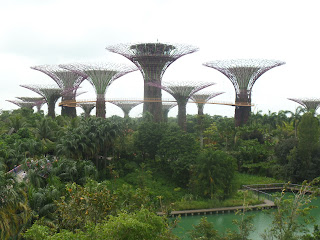I am sitting in the lounge in Singapore, having just drunk a good cup of coffee from the automatic machine. I am so pleased we have access, via our bank, to use the lounges in most airports. A chance for a little bit of relaxation before boarding the plane. Unfortunately we do not have access to lounges in Australia.
After getting out of the taxi we basked for a few minutes in the warm sunshine. It will be quite different when we step out of the terminal in London. It will be good to be home though, and to see Emma, Steve, Jackson and Isabel.
The last few photos of Singapore before we leave. A very well lit up Singapore at night.
The Merlion lit up with everchanging lights, all to the sound of music. All part of the Festival of Light.
The Marina Sands Bay Hotel, lit up at night.The view from our window, looking towardsthe Anglican Cathedral, and the Singapore Eye.
The other view from the window, looking towards the business district.
One evening we walked to Clarke Quay, on the Singapore River. An area that was once warehouses, and is now an upmarket area of bars and restaurants.Tour boats on the Singapore River.
The view up river towards Riverside Point.
Riverside Point.
The centre of Clarke Quay with plenty of sparkly lights.
Looking up at the roof, lit with everchanging lights.
One of the busy streets leading to the centre of Clarke Quay.
We never tire of visiting Singapore, as it is everchanging. It is also a vibrant, cosmopolitan and positive place to be in. When Singapore broke away from Malaysia and became an independent country in 1963 there was much to change. The Prime Minister and his cabinet brought in tough measures, some of which we saw when we lived here.
When we lived here, during the early 1970s, the government forced people out of their Kampongs and run down urban streets, and into flats in high rise buildings, where all the different ethnic groups had to live as neighbours. Areas of jungle were cleared away, almost overnight, in order to build high rise apartments. People were told to have two children only, any more children meant no free education or medical treatment. As new laws were brought in, they were implemented immediately. It was a tough time.
Consequently Singapore is now a spotlessly clean and successful country, with an upbeat atmosphere. There appears to be employment for everyone and a good quality lifestyle for the people.
So goodbye Singapore, until we return again.



























































